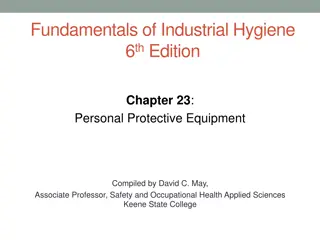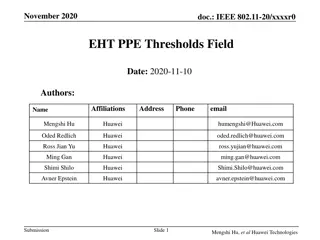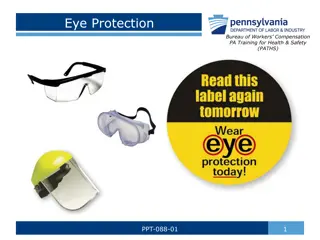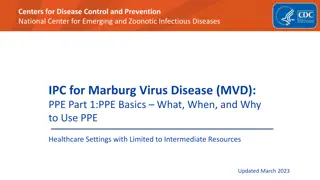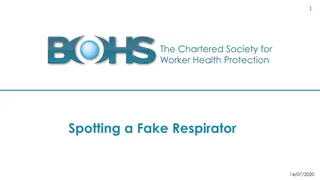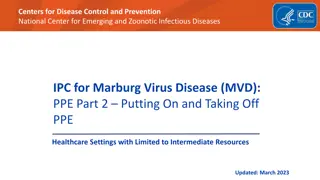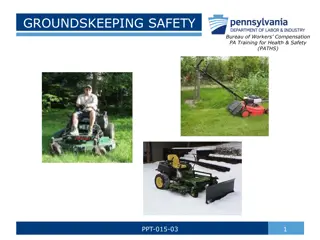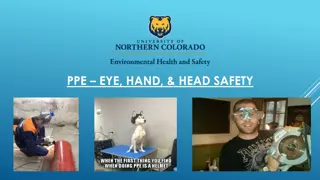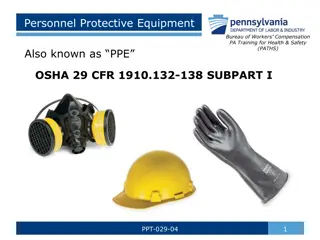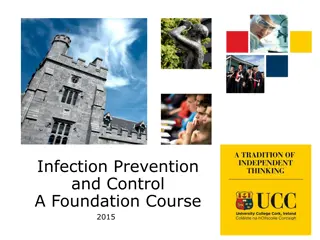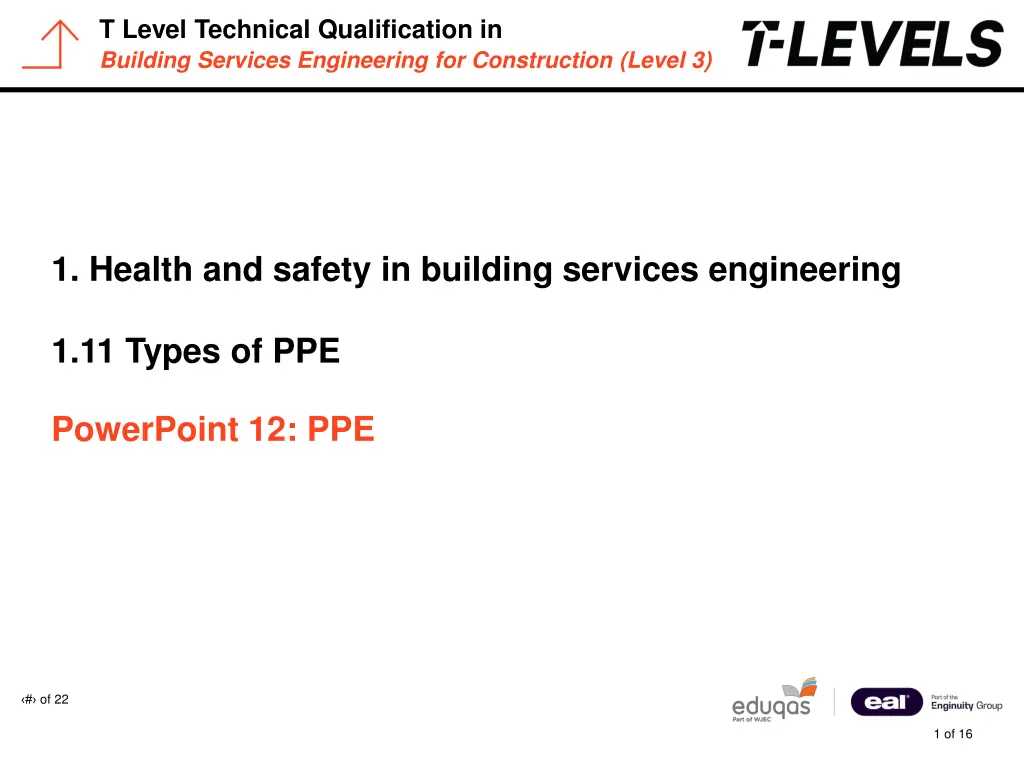
Essential PPE for Building Services Engineering
Discover the importance of Personal Protective Equipment (PPE) in building services engineering, including types like head protection and eye protection. Learn about the regulations, purpose, and correct usage of PPE to mitigate risks effectively.
Uploaded on | 1 Views
Download Presentation

Please find below an Image/Link to download the presentation.
The content on the website is provided AS IS for your information and personal use only. It may not be sold, licensed, or shared on other websites without obtaining consent from the author. If you encounter any issues during the download, it is possible that the publisher has removed the file from their server.
You are allowed to download the files provided on this website for personal or commercial use, subject to the condition that they are used lawfully. All files are the property of their respective owners.
The content on the website is provided AS IS for your information and personal use only. It may not be sold, licensed, or shared on other websites without obtaining consent from the author.
E N D
Presentation Transcript
T Level Technical Qualification in Building Services Engineering for Construction (Level 3) PowerPoint presentation 1.11 Types of PPE 1. Health and safety in building services engineering PowerPoint 12: PPE # of 22 1 of 16
T Level Technical Qualification in Building Services Engineering for Construction (Level 3) Objectives At the end of the session the learners should be able to: state the purpose of personal protective equipment (PPE) to mitigate risks identify the various types of PPE understand the correct methods of using PPE. # of 22 2 of 16
T Level Technical Qualification in Building Services Engineering for Construction (Level 3) PPE The guidelines that govern protective clothing are set out in the Personal Protective Equipment at Work Regulations 1992. PPE is defined as all equipment designed to be worn or held to protect against a risk to health and safety. PPE includes most types of protective clothing and equipment (eg, eye, ear, hand, foot and head protection). PPE is necessary when you cannot remove the hazard. PPE does not stop accidents but reduces the effects of an accident. # of 22 3 of 16
T Level Technical Qualification in Building Services Engineering for Construction (Level 3) PPE PPE is designed to protect you against workplace hazards. Your employer is obliged by law to provide the correct PPE. For example: protective clothing, overalls, etc. high-visibility (HI-VIS) wear eye protection gloves safety helmets safety footwear ear defenders dust masks, respirators. # of 22 4 of 16
T Level Technical Qualification in Building Services Engineering for Construction (Level 3) Head protection On site there is always the danger of objects falling from overhead, but helmets are also needed to protect against the danger posed by protruding objects. They are designed to protect the head against general bumps. Head protection is a requirement for site work and must be worn correctly and be well fitting. Examples of head protection are a safety helmet or hard hat, and a bump cap . # of 22 5 of 16
T Level Technical Qualification in Building Services Engineering for Construction (Level 3) Eye protection Protection for your eyes comes in many forms for different situations, each specific to the work being carried out. Eye protection shields you from heat, sparks, dust, dirt, flying objects and fumes. The different types of eye protection are: safety goggles safety visors safety spectacles face shields fixed shields. # of 22 6 of 16
T Level Technical Qualification in Building Services Engineering for Construction (Level 3) Ear protection When working in the construction industry, if noise levels reach 85db then ear protection should be worn to avoid damage to the hearing. This noise level can easily be reached when drilling, chasing, sawing or grinding. The type of protection you should use will depend on the work you are doing and the duration of the noise. The commonest types of ear protection are: ear defenders ear plugs. # of 22 7 of 16
T Level Technical Qualification in Building Services Engineering for Construction (Level 3) Protective clothing There are many types of workwear designed for use in different conditions, such as dust, dirt, heat, oil and grease. Some are even disposable, for use in certain situations. Types include: overalls safety trousers work jumpers work uniforms elbow protection. # of 22 8 of 16
T Level Technical Qualification in Building Services Engineering for Construction (Level 3) High-visibility wear As the name suggests, high-visibility (HI-VIS) clothing comes in bright colours to make the person easy to spot by other workers on site, such as crane operators and the drivers of site trucks. The clothing is typically reflective, for use in darker environments. High-visibility waistcoats are now a requirement for all site work. However, the following types of HI-VIS PPE are also available: safety trousers safety jackets. # of 22 9 of 16
T Level Technical Qualification in Building Services Engineering for Construction (Level 3) Hand protection Gloves are designed to suit specific types of work and protect the hands from hazards such as sharp objects and hot materials. The types of gloves available include: general rigger s gloves arm-length gauntlets chemical-resistant gloves heat-resistant gloves abrasion-resistant gloves cut-resistant gloves gauntlets electrician s gloves. # of 22 10 of 16
T Level Technical Qualification in Building Services Engineering for Construction (Level 3) Knee protection Some trades spend a lot of their working day on their knees (eg plumbers and electricians), and this can cause pain now and arthritis in later life. Knee protection is used to guard against this. For example: kneeling mats knee pads. # of 22 11 of 16
T Level Technical Qualification in Building Services Engineering for Construction (Level 3) Foot protection Good footwear will protect your feet against various hazards, including damp, sharp and heavy objects, chemicals and electricity. Standard site boots will need toe protectors, and some sites may require a steel mid- sole to protect the underside of the foot. This combination protects against dropping items on your foot or treading on nails. The types of foot protection available include: safety shoes safety boots safety trainers. # of 22 12 of 16
T Level Technical Qualification in Building Services Engineering for Construction (Level 3) Lung protection When working in the construction industry, dust and fumes are commonly encountered. To overcome these health and safety hazards, RPE (respiratory protective equipment) should be used: dust masks respirators breathing apparatus face-fit apparatus. # of 22 13 of 16
T Level Technical Qualification in Building Services Engineering for Construction (Level 3) Vibration protection Protection against arm and hand vibration for construction workers is vitally important to ensure that vibration white finger (VBW) does not affect the operative. This requirement is covered in the Control of Vibration at Work Regulations 2005 and this document sets out the protection required. Mitigation approaches for VBW include: risk controls alternative work methods equipment selection work limitation (vibration exposure) gloves. # of 22 14 of 16
T Level Technical Qualification in Building Services Engineering for Construction (Level 3) Fall protection When working at height in the construction industry, it is paramount that fall protection measures are put in place to mitigate the likelihood and consequences of a fall from height. For example: harnesses fall arrest lanyards safety nets edge protection airbag protection. # of 22 15 of 16
T Level Technical Qualification in Building Services Engineering for Construction (Level 3) Any questions? # of 22 16 of 16


